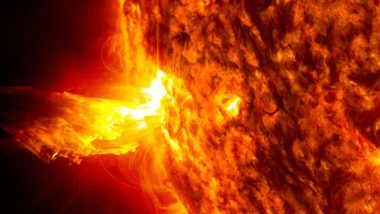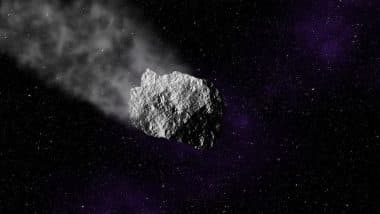Mumbai, January 23: A solar storm, triggered by a series of solar flares from the Sun, has hit Earth, resulting in radio blackouts and potential disruptions to technological infrastructure. The recent solar activity, characterised by two solar flares, caused a brief radio blackout over the Pacific Ocean and impacted the poles for several hours. The ongoing storm raises concerns about potential disruptions to power grids, radios, aviation communication, and satellite operations.
The National Oceanic and Atmospheric Administration (NOAA) has warned of a 60 per cent chance of disruptions to the power grid due to the ongoing solar storm. Another solar storm expected on Wednesday, January 24, could further affect various communication systems and satellite operations. According to multiple reports, NOAA's Space Weather Prediction Centre has classified the ongoing storm as a moderate R2 event, indicating its potential impact on Earth's magnetosphere. 'Solar Maximum' in 2024: Scientists Say Powerful Solar Storms Could Disrupt Earth's Internet Connectivity for Weeks; Here's Why.
What is a Solar Storm?
A solar storm occurs when the Sun emits charged particles and intense bursts of electromagnetic radiation. This phenomenon is often triggered by a "sympathetic solar flare," where two sunspots, AR3559 and AR3561, flared simultaneously in different hemispheres. This double ultraviolet flash from the Sun's surface triggered a shortwave radio blackout over Australia and Indonesia. The interconnected magnetic loops within the sun's corona are responsible for these simultaneous flares. While these solar storms pose challenges to Earth's technological systems, they also offer a breathtaking celestial display. Earth Closest to Sun Today: When Is Perihelion Day 2024? Know the Date and Distance at Which Earth Will Be Closest to the Sun in Full Year.
The geomagnetic storms induced by the coronal mass ejections (CMEs) are expected to produce stunning auroras visible as far south as Wyoming, South Dakota, Iowa, Wisconsin, Michigan, New York, and other northern regions. Solar storms occur when the solar wind interacts with Earth's magnetosphere, potentially causing disturbances. The impact includes disruptions to navigation systems, radio signals, and GPS signals. While the ongoing storms are not expected to bring major impacts, they highlight the Sun's dynamic influence on Earth's space environment.
(The above story first appeared on LatestLY on Jan 23, 2024 04:45 PM IST. For more news and updates on politics, world, sports, entertainment and lifestyle, log on to our website latestly.com).













 Quickly
Quickly





















